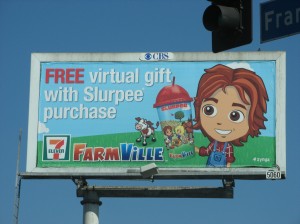FarmVille in the real world
June 18th, 2010 at 11:49 pm (Games, Psychology, Society)
FarmVille is, I hear, some kind of game one plays on Facebook. Well, not just one; the game has over 82 million active users as of May 2010. I’ve never tried it myself, so I don’t really know what makes it so fun or addictive. And although I knew of it in passing, I thought it was confined to Facebook.
Not so.
 FarmVille (and its sister games such as Mafia Wars) have entered the real world, the one that you and I live in, through (of all places) 7-11. I was driving along a week ago when I noticed this billboard. That’s right, if you buy a Slurpee, you get a “virtual gift” in the FarmVille world. The gift turns out to be 200 “FarmVille dollars.” Am I the only one who finds this utterly bizarre? I’m aware that people buy and sell virtual goods for real dollars in Second Life. I know that some MMORPG players pay others real dollars to generate game commodities like experience points or gold. But for these virtual objects and services to obtain a “real world” value, they have to reach a certain level of social dissemination and perceived value in a large real-world community. And certainly, 82 million people is a large community — I hadn’t realized just how many people were playing this game.
FarmVille (and its sister games such as Mafia Wars) have entered the real world, the one that you and I live in, through (of all places) 7-11. I was driving along a week ago when I noticed this billboard. That’s right, if you buy a Slurpee, you get a “virtual gift” in the FarmVille world. The gift turns out to be 200 “FarmVille dollars.” Am I the only one who finds this utterly bizarre? I’m aware that people buy and sell virtual goods for real dollars in Second Life. I know that some MMORPG players pay others real dollars to generate game commodities like experience points or gold. But for these virtual objects and services to obtain a “real world” value, they have to reach a certain level of social dissemination and perceived value in a large real-world community. And certainly, 82 million people is a large community — I hadn’t realized just how many people were playing this game.
I now wonder how much of an incentive 200 $FV is. What’s that worth to anyone? Is there an exchange rate with USD? To those of you who’ve played FarmVille: would the promise of 200 $FV be enough to persuade you to buy a Slurpee?
jim said,
June 19, 2010 at 7:45 am
Not only is it utterly bizarre, it’s utterly profitable.
I have never played FarmVille, but for a brief period last year, I played Mafia Wars with some coworkers to kill the unproductive quantum chunks of time between meetings.
From an economic perspective, these games all work the same way: One slowly accrues a number of “Favor points” (Godfather points, Farmville dollars, etc) while advancing through the game. There are occasional bonuses (including virtual items!) to get users to do things (give the company your email, invite friends, install the toolbar/iphone app, just click on a random link and play). More directly, Zynga and others earn money when users purchase points, either directly or as a side effect of affiliate offers – join Netflix, sign up for a monthly credit scoring, donate your soul to a religious cult, etc. The billboard you show, like the photo I took in Baltimore, is an extension of this marketing.
Zynga and Facebook got into a tiff because Facebook wanted a 30% cut of the action. There’s a lot of money in the pay-for points.
“Favor points” are typically not exchangeable back to $USD. (I don’t know what the World of Warcraft folks do – apparently there are factories that play the game solely to generate “gold” that’s sold externally for money (or other things of value to gamers). In Mafia Wars, these favor points were used to improve a character’s overall attributes, allow more game time (by recharging “energy”, “stamina” or “health”), grow their team size or buying virtual loot (special weapons, magic beans, pink fedora, whatever). Yeah, exactly what you’re thinking now.
And it’s not just Zynga. Consider the recent World of Warcraft news item of a “Celestial Steed” for sale. This generated about $3m of cash in a week! Upon reading that, I wondered what the hell I’ve done wrong in my career.
Whenever you see a quoted user base, assume it’s including inactive accounts and (in the case of really rabid fans) duplicate accounts created solely for the game.
joni said,
August 14, 2010 at 7:50 pm
amen. THANK you someone else for understanding how i felt when i saw that billboard.